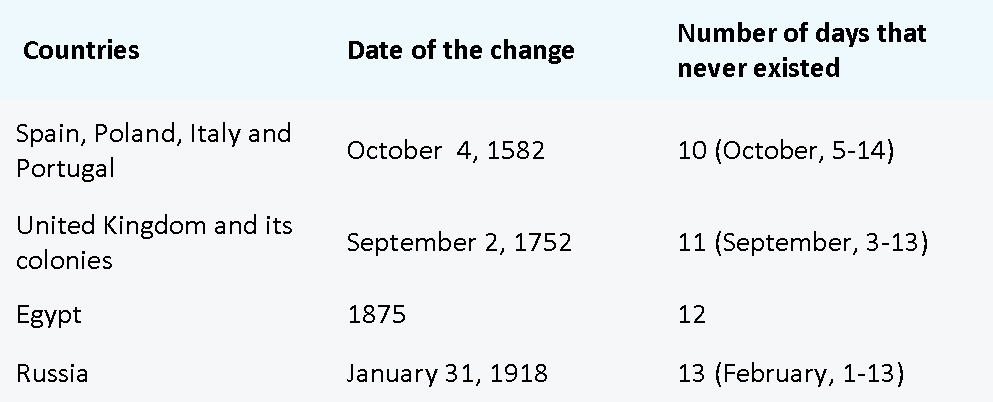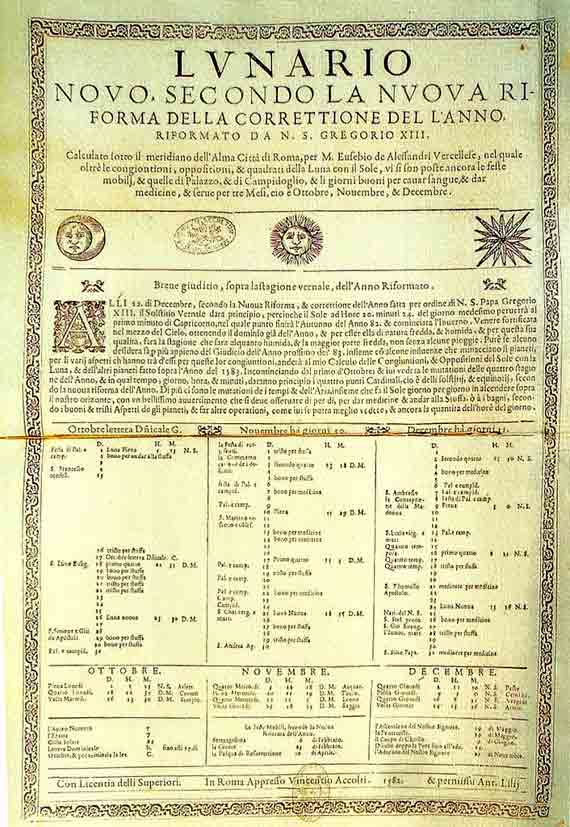William Shakespeare and Miguel de Cervantes both died on the same date: April 23, 1616. However, the Spanish writer died ten days before the English one. There is no puzzle or trick here, there were simply different calendars being used in Spain and England at that time. When Cervantes died on April 23, in England it was still the 13th. It was just random chance that Shakespeare’s life also ended on the 23rd according to the local calendar, when in Spain it was already May 3.
 The origin of this curious discrepancy goes back more than three decades earlier, when the reform that introduced the Gregorian calendar was first adopted. Until 1582, the Western world was governed according to the Julian calendar, introduced by Julius Caesar in 46 B.C. The problem was that the Julian calendar was not faithfully adapted to the natural year. The result was that, over the centuries, the start of Spring had advanced until March 10.
The origin of this curious discrepancy goes back more than three decades earlier, when the reform that introduced the Gregorian calendar was first adopted. Until 1582, the Western world was governed according to the Julian calendar, introduced by Julius Caesar in 46 B.C. The problem was that the Julian calendar was not faithfully adapted to the natural year. The result was that, over the centuries, the start of Spring had advanced until March 10.
The search of a more natural calendar
But since the date of Easter is calculated by a rule called Computus, which depends on the calendar, the celebration of the Christian Easter had moved away from its traditional link with the Spring equinox. According to what astronomer and Jesuit George V. Coyne, former director of the Vatican Observatory and co-editor of the book “Gregorian Reform of the Calendar” (1983), summarized for OpenMind, «Easter was becoming a Winter festival.»

In the sixteenth century, Pope Gregory XIII took on the task of designing a new calendar. Possessed with a reformist spirit and known as a great promoter of the Arts and Sciences, Gregory XIII assigned the task to a committee that adopted the calendar created by Italian Aloysius Lilius and perfected by German Christopher Clavius. The new calendar was more faithful to the natural year, but it was also necessary to compensate for the accumulated error to date; the papal bull “Inter Gravissimas”, published on February 24, 1582, provided that Thursday, October 4 of that year would be followed by the first day of the new calendar: Friday, October 15. This was how ten days disappeared (from October 5 to 14). The choice of date was no accident; according to Coyne, «they were the days on which there were the fewest feasts of saints.»
Spain, Portugal, Italy and Poland were the early adopters
Spanish King Philip II, a great ally of Gregory XIII, immediately adopted the new calendar in his territories, including Spain, Portugal, Italy and many of the overseas colonies. So did the Polish-Lithuanian Commonwealth. France followed suit on December 9, and soon after some provinces of the Netherlands did the same. However, other non-Catholic countries or those with considerable Protestant minorities resisted the change.
As explained to OpenMind by Father Paul Gabor, astronomer and deputy director of the Research Group of the Vatican Observatory in Tucson (Arizona), «adopting the Gregorian calendar would have been a recognition of papal authority,» something unthinkable then in England. «Considering all this, the better question is, how is it possible that the Gregorian calendar has become the dominant timekeeping scheme in today’s world?» reflects the Jesuit.
Fear of losing ten days of life
Although the papal bull specified that the ten lost days would not be considered for tax purposes and debt maturities, the truth is that, from that moment on, a duality of calendars was created. «It took some time for daily life to adjust,» says Coyne. For his part, Gabor believes that the impact was minimal: «Curiously, authors who write about the reluctance of ordinary people to accept the new calendar seem to focus on the (obviously groundless) fear that the transition would somehow take 10 days away from people’s lives.»
However, the period of two calendars resulted in some odd situations. King William III of England sailed from the Netherlands on November 11, 1688 and touched port in Brixham on November 5; Britain and its empire would not adopt the reform until September 2, 1752. In Alaska the change came into force on October 6, 1867, when the territory was acquired by the United States from Russia. In that country the Julian calendar still ruled; in fact, the October Revolution of 1917 happened in November 1917 for the Western world, as Russia would not change systems until January 31, 1918. Until 1923, when Greece became the last European country to make the change, it was common for documents to reflect two different dates. Today the Gregorian calendar prevails in most of the world, although the Christian Orthodox churches remain faithful to the Julian system.
A great astronomical challenge
The root of all this mess, in the words of Coyne, is that «the three natural units of time (day, month and year) are not commensurable». Historically, the definition of a precise calendar has been «one of the most important motivations for studying astronomy,» according to what Jesuit astronomer Guy Consolmagno, director of the Vatican Observatory, explained to OpenMind. Many historical calendars, such as the Islamic one, are based on lunar cycles, with an average month lasting 29.5 days. The problem is that there is no link between lunar cycles and the solar year. The Roman calendar, originally lunar, became luni-solar by adding a time adjustment that was not assigned to any month.

The reform of Julius Caesar addressed this problem by introducing a solar calendar, but there was an additional drawback: the calendar year does not last exactly 365 days, but rather 365.24219, on average. To compensate for this error, the Julian calendar invented the leap year (366 days), adding an extra day every four years and thus giving each year an average of 365.25 days. Even in this case, an error of one day still accumulated every 128 years. This is why in the 16th century, the Spring equinox had already advanced until March 10, which justified the need for the Gregorian Reform in 1582— and the loss of ten days to adjust. Countries that switched some centuries later accumulated an even bigger gap, so in Russia there were thirteen days that never existed in 1918.
The Gregorian Calendar, now used worldwide, dictates that years divisible by 100 are leap years only if they are also divisible by 400 (i.e. the year 2000 was a a leap year, but the year 1900 wasn’t and neither will be the year 2100), resulting in an annual average length of 365.2425 days and an error of only one day every 3,226 years: following the current calendar, we won’t have to leap a single day until year 4808.
Comments on this publication